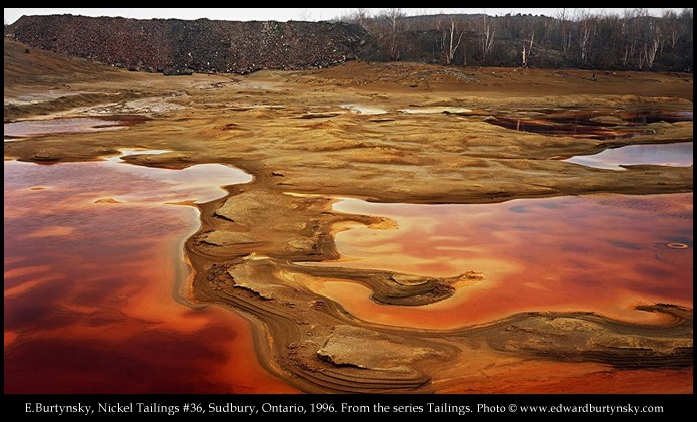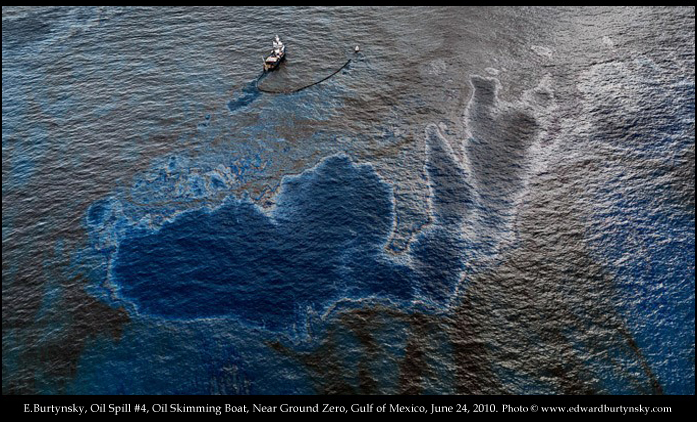“(..) whatever is in any sort terrible, or is conversant about terrible objects, or operates in a manner analogous to terror, is a source of the sublime; that is, it is productive of the strongest emotion which the mind is capable of feeling”

In the midst of the 18th century, the British statesman Edmund Burke summarizes in these words his concept of the Sublime.
Climbing over the boundaries of time we might use the same words for describing the Edward Burtynsky’s photographs.

Son of Ukrainian emigrants, the artist – born in 1955 in St. Catharines, Ontario- had his first approach with the photographic process at eleven years old with his father. Afterwards he studied graphic arts at Niagara College, and photography at Ryerson Polytechnical Institute. Today Edward Burtynsky is known as one of Canada’s most respected photographers and his works are housed in over fifty museums worldwide.
For about 35 years the artist has been paying attention to the intricate connection between industry and nature. His pictures, accosting raw elements produced by humans to natural panorama, arouse “Attraction and repulsion, seduction and fear” fully embodied the dialectic of the Sublime.

The mains protagonists of the Burtynsky’s artworks are the human systems imposed upon a landscape. His imagery explores this controversial relationship blending the rough elements of quarrying, shipping (Shipbreaking #13, 2000), leach residue (Nickel Tailings #36, 1996), oil production (SOCAR Oil Fields #3, , 2006) into eloquent, highly suggestive visions.
Fervent environmentalist, Burtansky started his artistic pursuit spurred by a question: “what we are doing as a species?”
Behind his photographic shots there is a keen research work – often assisted by experts in the field –for which he has often been led around the world. His pictures are known for meticulousness and attention to detail; an example is provided by the project Water for which Burtansky waited several months for the right weather and lighting conditions. Since the early works, he has preferred to print his photos in a monumental scale. For this purpose he often photographs from a helicopter.
Oil, Water, Tailings, Mines, Shipbreaking, Quarries and Manufactured Landscape are only someone of the several projects realized. His photographs intend to show the complicated and often dysfunctional way of how we interact with the environment trying to represent what is happening on a large scale.
Proposing these “Unfamiliar Landscape” Burtansky tracks the aim to reconnect the origin of the processes/system with the daily life. The viewer is encouraged to become aware of his surroundings. In this regard exemplary is the project Oil. Starting from a reflection about the car, the artist began his search:
“ The automobile is the main basis for our modern industrial world, giving us a certain freedom and changing our world dramatically. The automobile was made possible because of the invention of the internal combustion engine and its utilization of both oil and gasoline. The raw material and the refining process contained both the idea and an interesting visual component for me.”

Through a simultaneously aggressive and seductive aesthetic that combines tremendum et fascinans, the viewer is placing in the question-asking-role. The dialectic of the sublime, of purely passive nature, is reprocessed in an active way.
At the initial delight, merely contemplative, follows the awareness and the potential engagement.
In order to foster this kind of approach, Burtansky has justified the choice to avoid “blue skies and green trees” because part of those “familiar landscapes” unable to surprise us.
Nevertheless, one of the prerogatives of the Canadian artist consists to make free the viewer to provide one’s own judgment.
According to its opinion the photos must be points of discussion and not a means politically addressed. The viewer sees in it what he feels nearest: pure aesthetical tools, industrial heroism or environmental boost. In an interview for Venue Burtansky said:
“Humans can really reveal themselves through what they choose to see as the most important or meaningful detail in an image.”

An example of this aesthetic ambiguity is provided by Burtynsky’s “Shipbreaking” photographs.
Although a damaging phenomenon, consequence of the modern industrialization, these huge shipwreck looks to be dangerous, controversial and entirely fascinating. In this picture we are in front of what Burke called “source of the sublime”.
In addition to the camera, the artist has also made films and has written books.
Is the case of Water Project in which, along side of the pictures, directed -in conjunction with Jennifer Baichwal- the documentary Watermark.
Burtynsky, starting from the awareness of the problems of drought in California, make evident the indispensable nature of the water for the mankind.
“Human ingenuity and the development of its industries have allowed us to control the Earth’s water in ways that were unimaginable even just a century ago. While trying to accommodate the growing needs of an expanding, and very thirsty civilization, we are reshaping the Earth in colossal ways. In this new and powerful role over the planet, we are also capable of engineering our own demise. We have to learn to think more long-term about the consequences of what we are doing, while we are doing it.”

Undoubtedly the environmental consciousness animate much of Burtynsky’s works. In this respect in the 2005 he won the TED Prize as a result of his way to underline the impact of humanity’s expanding on the Earth, Nevertheless WorldChanging.com and others famous websites use his photos to inspire ongoing global conversations about sustainable living. Furthermore Burtynsky founded the website for kids http://www.meetthegreens.org/ and chaired the board of directors of the online sustainability magazine “Worldchanging” until it was taken over by “Architecture for Humanity” in September 2011.
Definitely the artistic pursuit of Burtynsky is focused on the rapport between the mankind and the nature.
“[we] come from nature.… There is an importance to [having] a certain reverence for what nature is because we are connected to it… If we destroy nature, we destroy ourselves.”
His pictures transcend as a universal language and represent the quick way to transmit this relationship.
Andrea Nicoletti
Notes:
http://www.edwardburtynsky.com/
http://www.edwardburtynsky.com/site_contents/About/aboutBio.html
http://www.1stdibs.com/introspective-magazine/edward-burtynsky-at-chrysler-museum-of-art/
http://www.bartleby.com/24/2/107.html
https://knocktwiceblog.wordpress.com/2011/05/13/you-should-know-edward-burtynsky/
http://www.chrysler.org/exhibitions/edward-burtynsky-water/
http://dailyserving.com/2012/06/the-big-picture-an-interview-with-ed-burtynsky/
http://blog.longnow.org/02014/03/19/edward-burtynsky-seminar-flashback-10000-year-gallery/
http://v-e-n-u-e.com/Primary-Landscapes-An-Interview-with-Edward-Burtynsky
